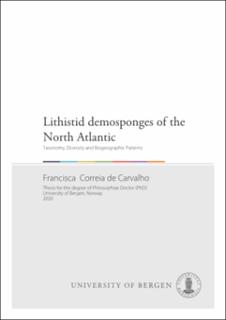| dc.contributor.author | Correia de Carvalho, Francisca | |
| dc.date.accessioned | 2020-12-14T10:16:02Z | |
| dc.date.available | 2020-12-14T10:16:02Z | |
| dc.date.issued | 2020-11-27 | |
| dc.date.submitted | 2020-11-18T05:18:17Z | |
| dc.identifier | container/44/a4/d9/93/44a4d993-7bc4-4157-8bdd-9f0998a95639 | |
| dc.identifier.isbn | 9788230850794 | |
| dc.identifier.isbn | 9788230840771 | |
| dc.identifier.uri | https://hdl.handle.net/11250/2719090 | |
| dc.description.abstract | Sponges, phylum Porifera Grant, 1836, comprise a group of benthic filter-feeding organisms, which are one of the oldest living groups of metazoans on Earth. Currently, four classes are recognized within the Phylum, of which class Demospongiae is the largest and most diverse containing approximately 83% of all species. Within this class, lithistids or rock sponges are a polyphyletic group united by the possession of a spicule type called desma. Desmas are articulated hypersilicified spicules, that frequently provide a hard consistency to these sponges. Due to this common trait, lithistid sponges were originally placed into an order, ‘Lithistida’ Schmidt, 1870. Even though their polyphyletic nature was acknowledged for a long time, only recently, their phylogenetic relationships were clarified using molecular data. This led to major changes in their classification, with the majority of species and families being assigned to the order Tetractinellida Marshall, 1876.
Lithistids are typically found in tropical and warm temperate regions at bathyal
depths, yet few species can also occur in shallower waters, usually in caves and reef tunnels. Globally, lithistid faunas are well known from the tropical western Atlantic and the south-west Pacific archipelagos of New Caledonia, New Zealand and the seamounts of the Norfolk Ridge. On these areas, lithistids are remarkably diverse and dominate the faunal assemblages. In the Northeast Atlantic (NEA), knowledge of the lithistid fauna was mostly restricted to the Azores archipelago and some species were known to occur on other Macaronesian Islands. However, the majority of those descriptions were historical and knowledge on their diversity and distribution was sparse and scattered in the literature. Moreover, molecular data of lithistid species occurring in the NEA was almost inexistent.
The main aim of this PhD thesis was to deepen our knowledge on the diversity
and distribution of lithistids in the NEA, and to investigate their biogeographic patterns across the North Atlantic and Mediterranean Sea. This project aimed to: 1) provide a taxonomic account of lithistids in the NEA and contribute to their classification; 2) investigate the spatial and bathymetric patterns of diversity and distribution in the North Atlantic; and 3) assess the biogeographic affinities across the North Atlantic and Mediterranean Sea.
This work provides a comprehensive account of the lithistid fauna of the NEA. Following a taxonomic integrative approach, several species were re-described, the molecular diversity and phylogenetic affinities were investigated, and, new geographic and bathymetric records added. Furthermore, 11 new species to science were described and illustrated, providing new insights into areas where there was a gap of knowledge, such as the NEA seamounts. In order to compile and update information on the species occurring in the NEA and Mediterranean Sea (MED), a taxonomic key was developed.
This thesis also presents the most comprehensive analysis on the on the diversity and distribution of lithistids spanning the entire North Atlantic (NA) and MED. The extensive review of the literature coupled with the analysis of new material, assembled information on diversity, spatial and bathymetric patterns of distribution across the study area. The encountered patterns were assessed in light of the current marine biogeographic classification systems (MEOW and GOODS). The addition of phylogenetic reconstructions has allowed the study of the biogeographic affinities of the faunas of the NA and MED, for the first time.
Once considered a relic from the past, increased attention given to this group in the last decades, resulted in the description of several new species and the discovery of large and diverse assemblages. This thesis not only shows how understudied this group and the deep-sea fauna is, but also adds essential knowledge for the conservation of deep-sea species and habitats, particularly in face of the increasing anthropogenic pressures on the deep-sea biome. | en_US |
| dc.language.iso | eng | en_US |
| dc.publisher | The University of Bergen | en_US |
| dc.relation.haspart | Paper I. Carvalho F.C., Pisera A. (2019). Revision of the genus Exsuperantia Özdikmen, 2009 (Tetractinellida: Phymaraphiniidae) with description of a new species from the Atlantic Ocean. Zootaxa 4613 (1): 135–151. The article is available at: <a href="https://hdl.handle.net/1956/23444" target="blank">https://hdl.handle.net/1956/23444</a> | en_US |
| dc.relation.haspart | Paper II. Carvalho F.C., Cárdenas P., Ríos P., Cristobo J., Rapp H.T., Xavier J.R. (2020). Rock sponges (lithistid Demospongiae) of the Northeast Atlantic seamounts, with description of ten new species. PeerJ 8:e8703. The article is available in the main thesis. The article is also available at: <a href="https://doi.org/10.7717/peerj.8703" target="blank">https://doi.org/10.7717/peerj.8703</a> | en_US |
| dc.relation.haspart | Paper III. Xavier J.R., Rees D., Pereira R., Porteiro F.M., Colaço A., Pham C., Carvalho F.C. Diversity, distribution and phylogenetic relationships of deep-sea lithistids (Porifera, Heteroscleromorpha) of the Azores archipelago. Not available in BORA. | en_US |
| dc.relation.haspart | Paper IV. Carvalho F.C., Schuster A., Pomponi S.A., Rapp H.T., Malaquias A.M., Xavier J.R. Diversity patterns and biogeographic affinities of North Atlantic deep-sea rock sponges (lithistid tetractinellids). Not available in BORA | en_US |
| dc.rights | In copyright | |
| dc.rights.uri | http://rightsstatements.org/page/InC/1.0/ | |
| dc.title | Lithistid demosponges of the North Atlantic : Taxonomy, Diversity and Biogeographic Patterns | en_US |
| dc.type | Doctoral thesis | en_US |
| dc.date.updated | 2020-11-18T05:18:17Z | |
| dc.rights.holder | Copyright the Author. All rights reserved | en_US |
| dc.contributor.orcid | 0000-0002-4885-3788 | |
| dc.description.degree | Doktorgradsavhandling | |
| fs.unitcode | 12-60-0 | |
